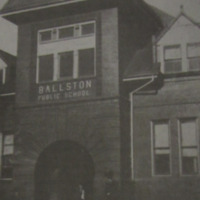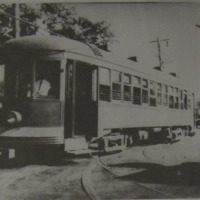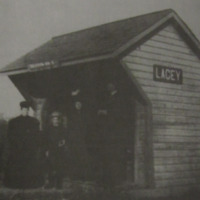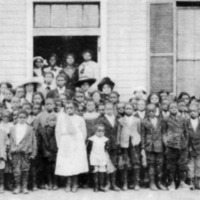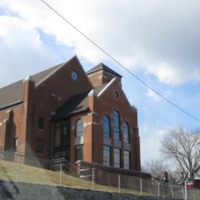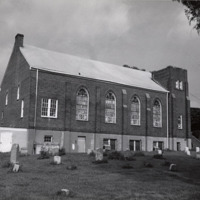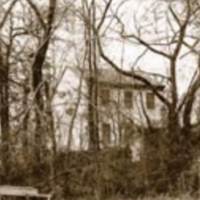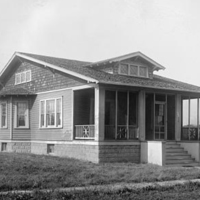Browse Items (79 items total)
Ballston was one of the first communities in Arlington to have a school. Originally called Walker School, the school was opened at the Good Templar's Hall in Balls' Cross-Roads the first year the County began sponsoring public school in 1871. After using this space for six years and a small wood-frame school house from 1878 to 1893 the new Ballston School house, pictured here, was opened in 1893. The red-brick, two story Ballston School had the same design as the Hume School which still stands.
This image from 1907 shows Carl Porter and his mother standing in front of Ballston School.
This image from 1907 shows Carl Porter and his mother standing in front of Ballston School.
Collection: Community Institutions
Here a trolley car from the Washington, Arlington, and Fall's Church Railway line approaches the Lacey Station in Ballston. Trolley lines helped further growth of Arlington's late-eighteenth century communities, like Ballston, as well as the nearly two dozen new nineteenth century communities. They helped to spur the development of Arlington as a suburban enclave of Washington, D.C. by providing easier access for commuters.
Collection: Neighborhoods
The Lacey Station was one of the stops used for the Ballston community on the Fairfax Line of the Washington, Arlington, and Fall's Church Railway. In the nineteenth and early-twentieth century trolley and railway development expanded commuter travel, encouraging and reacting to a rising commuter community in Arlington County.
Here, Carl Porter and his family are pictured at the station in 1906.
Here, Carl Porter and his family are pictured at the station in 1906.
Collection: Neighborhoods
Kemper School was the African American school for the the Green Valley community, Kemper opened in 1875 within Green Valley's AME Zion Church. Upon it's opening, Kemper was one of three schools for African American children, joining schools in the black communities of Hall's Hill and Freedman's Village.
In 1885 the school moved to a one-story, wood-frame school house on 3/4 of an acre of land. The school was named for Virginia Governor James L. Kemper who supported education for African Americans. By 1893 the school had outgrown its original structure and a new brick, two-story school house was created by Noble Thomas, the first black contractor in the county. In 1944 the school expanded further with the addition of the Kemper Annex, which was renamed Drew in 1955 in honor of leading African American blood plasma researcher and Arlington resident Dr. Charles Drew.
In 1964 Kemper ceased to function as a school, replaced by the larger Drew School. The building was demolished in the 1980s to make room for partially subsidized town-homes.
In 1885 the school moved to a one-story, wood-frame school house on 3/4 of an acre of land. The school was named for Virginia Governor James L. Kemper who supported education for African Americans. By 1893 the school had outgrown its original structure and a new brick, two-story school house was created by Noble Thomas, the first black contractor in the county. In 1944 the school expanded further with the addition of the Kemper Annex, which was renamed Drew in 1955 in honor of leading African American blood plasma researcher and Arlington resident Dr. Charles Drew.
In 1964 Kemper ceased to function as a school, replaced by the larger Drew School. The building was demolished in the 1980s to make room for partially subsidized town-homes.
Collection: Community Institutions
Mount Zion Baptist Church is a brick structure which features a gabled roof and right form tower.
The church congregation was originally founded within the Old Bell Church in Freedman's Village in 1866. In the late-1860s the Old Bell Church was demolished and the church split into two congregations - Mt. Olive and Mt. Zion Baptist churches. Both formed in the community of Queen City. In 1942 the federal government condemned the church and surrounding community to make way for the road networks of the Pentagon. The congregation moved to Green Valley where they opened the current church in July on 1945.
The church congregation was originally founded within the Old Bell Church in Freedman's Village in 1866. In the late-1860s the Old Bell Church was demolished and the church split into two congregations - Mt. Olive and Mt. Zion Baptist churches. Both formed in the community of Queen City. In 1942 the federal government condemned the church and surrounding community to make way for the road networks of the Pentagon. The congregation moved to Green Valley where they opened the current church in July on 1945.
Collection: Community Institutions
The Lomax Afro Methodist Episcopal (AME) Zion Church is a 45' x 72' two-story, gabled roof, brick structure. The church features a small cemetery to the right side where approximately 50 church members and community leaders were interred from the 1880s to 1965.
The church first began as Little Zion Methodist Church in Freedman's Village in 1866. In the 1880s the congregation moved to Green Valley. Before a new church building could be created services were held in the home of community leaders Levi and Sarah Ann Jones. In 1876 a one acre plot was purchased for $75 and a new church, now called Lomax AME Zion, was constructed, using wood preserved from the original Freedman's Village structure. The church was expanded in 1889 and in 1922 the present building was completed.
The church first began as Little Zion Methodist Church in Freedman's Village in 1866. In the 1880s the congregation moved to Green Valley. Before a new church building could be created services were held in the home of community leaders Levi and Sarah Ann Jones. In 1876 a one acre plot was purchased for $75 and a new church, now called Lomax AME Zion, was constructed, using wood preserved from the original Freedman's Village structure. The church was expanded in 1889 and in 1922 the present building was completed.
Collection: Community Institutions
In 1861 the Fort Barnard Fortifications were constructed as part of the Civil War defenses of Washington in Green Valley. The fort was named for General J.G. Barnard, the chief engineer for the defenses of Washington. The fort had significant earth works and gun platforms which featured twelve 24-32 pounder guns. During the war the fort was occupied by the 3rd Artillery Battery of the New York and the 14th of Massachusetts.
In 1902 the site was preserved as a park and community playground.
In 1902 the site was preserved as a park and community playground.
Collection: Community Institutions
Levi Jones and his wife Sarah were two of the earliest settlers of Green Valley, today known as Nauck.
In 1844 the couple built a 14' x 16', two story log cabin. During the Civil War, federal troops destroyed their original home. But following the war they were able to rebuild, creating the home pictured here.
The Jones were influential community leaders. Before other accommodations could be made, they hosted church services in their home. They sold land to freed slaves following the Civil War. These sales, along with interest from Washington, D.C. land speculator John Nauck, a white businessman who sold land to African Americans in the Green Valley area, strengthened and expanded the black community there. Their impact on Nauck's black community continued into the twentieth century, when the federal government built the Paul Dunbar Homes on 11 of their original homestead in 1942.
Levi and Sarah had two sons, Levi and Isaac, and three daughters, Mary, Martha, and Louise. Levi died in 1886 and Sarah followed in 1913 at the age of 95. They are buried at the Lomax AME Cemetery.
In 1844 the couple built a 14' x 16', two story log cabin. During the Civil War, federal troops destroyed their original home. But following the war they were able to rebuild, creating the home pictured here.
The Jones were influential community leaders. Before other accommodations could be made, they hosted church services in their home. They sold land to freed slaves following the Civil War. These sales, along with interest from Washington, D.C. land speculator John Nauck, a white businessman who sold land to African Americans in the Green Valley area, strengthened and expanded the black community there. Their impact on Nauck's black community continued into the twentieth century, when the federal government built the Paul Dunbar Homes on 11 of their original homestead in 1942.
Levi and Sarah had two sons, Levi and Isaac, and three daughters, Mary, Martha, and Louise. Levi died in 1886 and Sarah followed in 1913 at the age of 95. They are buried at the Lomax AME Cemetery.
Collection: Neighborhoods
Bungalow homes, like this house in the Cherrydale neighborhood, were very popular in Arlington during the early twentieth century. The main characteristics of these homes are that they were one story with large front porches and sloping roofs. Bungalows came into fashion during the Progressive Era, as more ornate Victorian homes and ideals were rejected in favor of the simpler Bungalow style which pushed connection to nature, simplicity, and honesty. By WWI this was the most common housing type nationally and in Arlington.
Many of Arlington's Bungalow houses were purchased through the Sears Roebuck mail-order catalog. The practice of ordering homes through mail-order was more popular in Arlington's white neighborhoods than its African American neighborhoods. Sears houses could be found in not only Cherrydale, but also Clarendon, Lyon Village, Maywood, Lyon Park, Ashton Heights, Alcova, Aurora Hills, and Virginia Highlands. This home appears to be in "The Vallonia" style.
Many of Arlington's Bungalow houses were purchased through the Sears Roebuck mail-order catalog. The practice of ordering homes through mail-order was more popular in Arlington's white neighborhoods than its African American neighborhoods. Sears houses could be found in not only Cherrydale, but also Clarendon, Lyon Village, Maywood, Lyon Park, Ashton Heights, Alcova, Aurora Hills, and Virginia Highlands. This home appears to be in "The Vallonia" style.
Collection: Neighborhoods
In May of 1942, U.S. Farm Security Administration photographer John Collier took pictures of homes and subdivisions under construction in Arlington, Virginia. Arlington saw a great deal of construction during World War Two as new homes and new neighborhoods were created in Arlington Heights, Green Valley, Fairlington, and more for war workers flocking to Washington.
Collection: Neighborhoods
